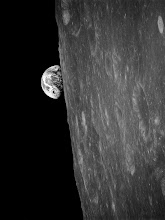A naked woman or hermaphrodite hovers or dances above the Earth holding a staff in each hand, surrounded by a green wreath, being watched by various creatures. In older decks, these are usually a human face or head, a lion, an ox, and an eagle, the symbols of the four Evangelists, Matthew, Mark, Luke, and John. It also holds reference to the vision of Ezekiel in the old testament. This is a reference to the all-encompassing knowledge of the Bible, the Word of God. Later decks avoid such blatant Christian symbolism, or ignore it altogether, choosing to explain these observers as representatives of the natural world, or the kingdom of beasts. An alternative explanation is based on astrological symbolism. The human face, bull, lion, and eagle represent the fixed signs of the zodiac, Aquarius, Taurus, Leo, and Scorpio. In some decks the wreath is a basilisk (crowned reptile) biting its own tail; this basilisk is also sometimes called an Ouroborous.In some decks, this card is also called "The Universe."
Interpretation
The World represents an ending to a cycle of life, a pause in life before the next big cycle beginning with the fool. The figure is at once male and female, above and below, suspended between the heavens and the earth. It is completeness.
The woman is surrounded by a wreath, representing water; a hawk, air; a lion, fire; an ox, earth; and a male figure as a spirit. Together, they make up the five elements. The four figures in the corners of the card are also referenced in the Book of Revelation, 4:7, "And the first beast was like a lion, and the second beast like a calf, and the third beast had a face as a man, and the fourth beast was like a flying eagle." . . Wikipedia
The Ouroboros, also spelled Ourorboros, Oroborus, Uroboros or Uroborus (pronounced /ˌjʊəroʊˈbɒrəs/ or /ʊˈrɒbɔrɔs/), is an ancient symbol depicting a serpent or dragon swallowing its own tail and forming a circle. It has been used to represent many things over the ages, but it most generally symbolizes ideas of cyclicality, unity, or infinity. The ouroboros has been important in religious and mythological symbolism, but has also been frequently used in alchemical illustrations. More recently, it has been interpreted by psychoanalysts, such as Carl Jung, as having an archetypical significance to the human psyche.The name ouroboros (or, in Latinized form, uroborus) is Greek ουροβóρος, "tail-devourer". The depiction of the serpent is believed to have been inspired by the Milky Way, as some ancient texts refer to a serpent of light residing in the heavens. . . Wikipedia
The word yoni (Sanskrit योिन yoni) is the Sanskrit word for "divine passage", "place of birth", "womb" in the sense of 'source of life' rather than a human organ, or "sacred temple" (cf. lila). The word also has a wider meaning in both profane and spiritual contexts, covering a range of meanings of "place of birth, source, origin, spring, fountain, place of rest, repository, receptacle, seat, abode, home, lair, nest, stable" (Monier-Williams). The yoni is also considered to be symbolic of Shakti or other goddesses of a similar nature. . . Wikipedia
In astrology, there are four fixed signs.
Fixed Signs are at the height of the four seasons. Fixed Signs are associated with stamina, perseverance and strength and said to be, by nature, inert. However, they are also associated with inflexibility. Individuals born under the four Fixed Signs of the Zodiac are thought to be determined, powerful, natural leaders, purposeful, reliable, loyal and self-confident but also occasionally stubborn and immovable, with a tendency to get stuck in ruts. They supposedly pursue their goals with dogged persistence and have a great power of concentration. According to astrologers, Fixed Signs tend to direct their energies inward rather than outward.
In Hermeticism, Kaballah, and some forms of esoteric Christianity, the four fixed signs are thought to correspond to the four tetramorphs in the prophet Ezekiel's vision or the four leading tribes of Israel: Judah of the East, Reuben of the South, Ephraim of the West, and Dan of the North. They are also thought to correspond with the four Gospel evangelists: Matthew (Christ the master), Mark (Christ the servant), Luke (Christ the human), and John (Christ the divine).
The four fixed signs of the Zodiac are:
- Taurus : Being an Earth sign , Taurus is said to be the most stable, patient and determined of all the Fixed Quality Signs.
- Leo : As a Fixed Fire sign, Leo individuals are said to burn with a greater intensity than the other two Fire Signs. They are supposedly much less impulsive than Aries natives and not as prone to "wanderlust" as Sagittarius subjects.
- Scorpio : A Water sign, of the Fixed Quality, Scorpio is thought to deeply internalize emotions and pursue goals with keen insights, perception and much willpower.
- Aquarius : An Air sign, while generally considered to be a spontaneous and erratic Sign, many astrologers also agree there is a distinct lack of flexibility in Aquarius character due to their Fixed Quality. . . Wikipedia
Macrocosm and microcosm is an ancient Greek schema of seeing the same patterns reproduced in all levels of the cosmos, from the largest scale (macrocosm or universe-level) all the way down to the smallest scale (microcosm or sub-sub-atomic or even metaphysical-level). . . Wikipedia
A fractal is generally "a rough or fragmented geometric shape that can be split into parts, each of which is (at least approximately) a reduced-size copy of the whole,"[1] a property called self-similarity. The term was coined by Benoît Mandelbrot in 1975 and was derived from the Latin fractus meaning "broken" or "fractured." . . Wikipedia "An extremely deep dive into the mandelbrot zoom. If the final frame were the size of your screen, the full set would be larger than the known universe."




















No comments:
Post a Comment